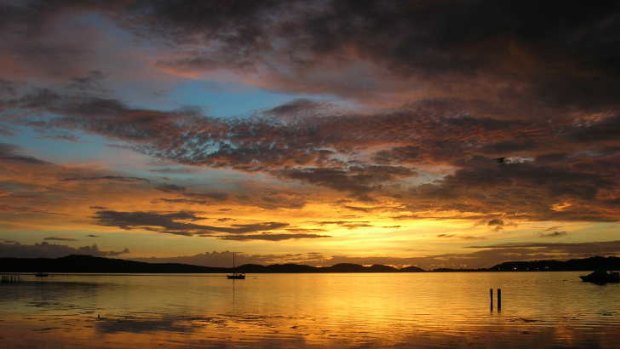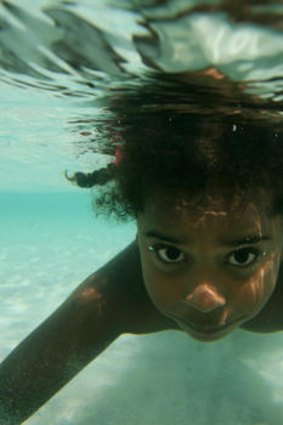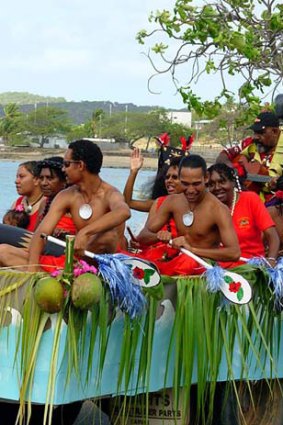
Sunset on Horn Island.
Surrounded by warm, azure waters and story-spinning locals, Emily Maguire explores the remarkable history and cultures of an often forgotten part of Australia.
IT'S a sultry 30 degrees outside but under the corrugated tin roof of Australia's northernmost pub it's cool as can be thanks to the whirring fans, the frosty beer and the mellow tones of local legend Seaman Dan. Although officially retired, the 82-year-old and two-time ARIA Award winner can be found at the Torres Hotel every Sunday playing his unique brand of hula-jazz and, during breaks, chatting about his music, his past as a pearl diver and his love of the place he has always called home, the Torres Strait.
As his moniker suggests, Seaman Dan has spent much of his life on the water so his passion for the strait is easy to understand. The waters here range from pale turquoise to vibrant azure and are home to dugongs, sea turtles, giant marlins, oysters and lobsters. They're also strewn with gorgeous but jagged coral reefs and riven by swiftly changing currents; 19th-century mariners called the strait a "sieve for ships".

The waters can be good for a dip (but go with a local).Credit: Andrew Meares
The 270 islands scattered across the 150-kilometre-wide waterway are remnants of a land bridge that once spanned the area between present-day Cape York and Papua New Guinea. Today, only 17 of the islands are inhabited and although they're all officially part of Queensland, the distinct communities inhabiting them make each feel like a nation of its own.
This year, two ABC television productions - Mabo, a telemovie about the Torres Strait's most celebrated son, and The Straits, a blackly comic crime drama set in the region - will showcase these islands and no doubt provoke an influx of tourists.
It's a good thing that more Australians will come to know this beautiful and fascinating part of their country but savvy travellers will beat the rush and get up there now, if only so they can say, "I knew it before it was famous".

A cultural parade on Thursday Island.
Seaman Dan's homeland is Thursday Island (Waiben in the indigenous language, TI to the locals). At little more than 3.5 square kilometres and with a population of about 2500, TI feels more like a country town than the commercial and administrative regional centre that it is. The two main streets - Douglas Street and Victoria Parade - run parallel to the beach and contain all the island's hotels and most of its shops, cafes and pubs.
Douglas Street is also where you'll find three of the most interesting of TI's many churches. The strongly religious character of the region is thanks to the efforts of the London Missionary Society, which first arrived on the far eastern island of Darnley (Erub) in 1871. This occasion is now celebrated throughout the islands as the Coming of the Light.
The oldest of TI's churches is the All Souls Quetta Memorial Cathedral, built in 1893 to commemorate the 133 people killed in the wreck of the RMS Quetta, three years earlier. The porthole, bell, life preserver and other items from the ship are on display. Next to All Souls is the Sacred Heart Catholic Church, the timber spires of which have become a landmark for those flying over the strait. Further along the street, past the Torres Hotel, is St Andrew's Uniting Church, a charming, sky-blue, missionary-style building with bright-red trim.
Walking past the Douglas Street churches on a Sunday morning, you'll hear joyful singing in a mixture of English and the Torres Strait creole known as Broken. Visitors are welcome to attend services or to go in and look around at other times.
For an insight into the far older spiritual beliefs of the islands, walk towards the waterfront for a minute or two to reach the Gab Titui Cultural Centre. Housed in a striking building reminiscent of a pearl lugger, Gab Titui consists of two galleries, a gift shop and the excellent Ilan Life Cafe. The paintings, sculptures and other cultural artefacts, many of which use locally sourced materials such as pearl shells and feathers, work together to narrate the ancient history and cultural legends of the Torres Strait Islander people. It's a history worth learning.
The Australian habit of referring to "Aboriginal and Torres Strait Islanders" when discussing indigenous people suggests a single cultural group but Torres Strait Islanders are ethnically and culturally distinct from mainland indigenous Australians.
Most indigenous Torres Strait Islanders are Melanesians, with strong familial and cultural ties to coastal New Guineans, although some do share cultural heritage with the Aboriginal peoples of Cape York. The original inhabitants of the islands hunted pigs and birds and cultivated small farms but it was the sea and all it contained that provided them with the majority of their food, as well as the means for trading and cross-cultural interaction with neighbouring islands, Cape York, Papua New Guinea and Indonesia. The displays in Gab Titui's main gallery reflect this ancient and continued connection to the sea, its gifts and its dangers.
The centre also houses the Ephraim Bani Gallery, which is dedicated to the preservation of ailan kastom (island culture), with displays on issues of importance and cultural identity.
Islander dedication to ailan kastom is strong but you shouldn't get the impression that Thursday Island is monocultural. Hanging in the front bar of the Federal Hotel (corner of Victoria Parade and Jardine Street), it's easy to fall into conversation with the chatty, laid-back locals, curious about visitors to their island. Once they've heard all about you and where you're from, they will, if you're lucky, tell you some of their stories. In one afternoon at the Federal, I spoke to Islanders of Malay, Japanese, Aboriginal and Dutch descent. Each had a story about how their forebears had come to call this remarkable, frequently forgotten piece of Australia home.
If you don't have the time or inclination to while away hours at the pub, you can still get an insight (though a less lively one) into the multicultural history of the strait by heading up to the Thursday Island Cemetery (Aplin Road).
When international trading ships started coming through in the 17th century, the local people supplemented their livelihoods by trading goods such as turtle shells, feathers and pearl shells. Word of the quality and abundance of pearls in Torres Strait seabeds began to spread to the outside world and, by 1890, hundreds of Japanese, Malay, Filipino, Maori, Singhalese, Indonesian, Indian and European fortune seekers, divers and indentured labourers had set up base on Thursday Island. The astonishing mix of Islamic, Christian, Buddhist and Shinto graves bearing names from all over the world is a stark reminder of how many of these adventurers met early deaths far from home thanks to the perilous strait and the dreaded bends.
The large Japanese section of the cemetery, the final resting place for more than 600 Japanese divers and - rumour has it - a Japanese princess, is said to be the reason TI was spared Japanese aerial bombardment during World War II.
Strolling along the near-silent foreshore, watching a tin dinghy bobbing in the turquoise water, breathing in hot, frangipani-scented air, it's hard to believe this place was disturbed by war. The idea seems a little less far-fetched after making the short climb up Green Hill on the island's west and checking out the fort and the small but interesting Torres Strait Museum in the bunker below. From the top of Green Hill you get uninterrupted, spectacular views of the neighbouring islands, including Horn Island (Narupai), which was not as lucky as TI during the war. As home to the most northerly Allied airbase in Australia, Horn Island suffered regular aerial swoops and was bombed eight times.
Between 1940 and 1945 more than 5000 Australian servicemen and women served on the island, among them almost every Torres Strait Island man of eligible age. This volunteer force of 880 men (who were paid only a third of that received by non-indigenous soldiers) formed the Torres Strait Light Infantry Battalion, the only indigenous battalion in Australian history.
The fascinating, largely unknown military history of Horn Island can be explored thoroughly at the Torres Strait Heritage Museum and Art Gallery (torresstrait.com.au/museum.html), which contains hundreds of photographs, maps and other artefacts from World War II. It also contains displays from the pearl-diving era and an impressive collection of indigenous art.
Probably the best way to experience all this history and culture is to book a tour with museum curators (and members of a fifth-generation Torres Strait family) Vanessa and Liberty Seekee, who run tours of key military sights including the trenches, a concrete bunker and the remains of a crashed US plane. Military history aside, there's not much for tourists on Horn Island, the majority of which is Aboriginal freehold land belonging to the Kaurareg people. Permission is required to enter most areas outside the small cluster of hotels and the wharf. (If in doubt, check with a local.)
Of course, as Seaman Dan might say, what are you here for if not the water? With temperatures of 25 degrees to 30 degrees year-round, taking a dip in the sparkling blue sea is tempting but unless you're with a local, you should stick to the hotel pool because there might be crocodiles, stingers and other nasties lurking beneath the seemingly calm surface.
Likewise, while fishing is a way of life in the Torres Strait, visitors planning on anything more than angling from the wharf need to be careful. Apart from potential run-ins with unfriendly marine life, reefs and sandbanks, there are cultural (and legal) considerations due to the protected status of much of the sea and its inhabitants. Booking a fishing tour with a local guide such as Tony Titasey (tonysislandadventures.com.au) will ensure you stay safe and catch only what you should (but plenty of it).
Silent night-fishing off the wharf, resting beneath a coconut palm or yarning with new friends at the beachfront pub, it can feel as if you've found your own secret slice of paradise. But word is getting out, with tourist numbers increasing every year.
Trip notes
Getting there
QantasLink flies to Horn Island (which houses the region's only commercial airport) via Cairns twice daily. Coaches wait at the airport to transfer passengers to the ferry terminal for the trip to Thursday Island (tiferry.com.au). SeaSwift (seaswift.com.au) offers passenger berths on its cargo trips — five-night round trips from Cairns depart on Fridays starting at $775 a person and include stops on Horn and Thursday islands. There are also twice-daily ferries from Cape York (peddellsferry.com.au) direct to Thursday Island, from $56 one way.
Staying there
On Horn Island, both the Gateway Torres Strait Resort (rooms from $119 a night, 07 4069 2222, torresstrait.com.au) and the Wongai Hotel (from $185, 07 4083 1100, wongaibeachresort.bigpond hosting.com) offer self-contained, airconditioned rooms, a swimming pool and a licensed restaurant.
The original Grand Hotel (from $185, 07 4069 1557, grandhotelti.com.au) on Thursday Island, at which Somerset Maugham is said to have written several stories, burnt down in 1993 but the new building retains the original's perfect position, metres from the wharf.
The Thursday Island Motel (from $220, 07 4069 2500, thursdayislandmotel.com.au) has clean, airconditioned rooms behind the character-filled Federal Hotel. Ask for a room towards the back because the pub gets rowdy at night.
Visiting the other islands
Visitors require permission to visit islands other than Thursday and Horn. Tourist infrastructure, accessibility and the ease of obtaining a visitor permit vary widely and which islands are worth the effort will depend on your particular interests.
Hammond Island (Keriri), a short water taxi ride from Thursday Island, became a Catholic mission for mostly Filipino pearl industry workers in 1929. It is worth visiting for the stunning hilltop St Joseph's Church. Hand-built using blue granite stones, it features porthole-style windows filled with glass bottles whose bases send shards of amber light into the church when the sun shines.
If camping, hunting and bushwalking are your things, you will love Prince of Wales Island (Muralug), which is the largest island in the Torres Strait, though the population is tiny. It is predominantly used as a recreational reserve for Thursday Islanders and other visitors.
For further information on any of the islands and to inquire about visitor permits, contact the Torres Strait Regional Authority (tsra.gov.au).
Sign up for the Traveller Deals newsletter
Get exclusive travel deals delivered straight to your inbox. Sign up now.